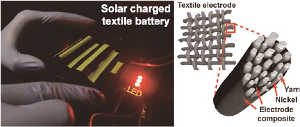
Portable electronic devices are pervasive in our society, keeping us connected to our offices and families regardless of where we are on the planet. From sensors that track daily caloric intakes and training regimes, to future uses of watching your favorite sporting event on the sleeve of your shirt, it is clear that wearable electronics will play an increasingly important role for consumers. With these advents, it will become paramount that rechargeable batteries be able to be seamlessly interfaced with fabrics to provide the requisite power over extended periods.
The recent report by Lee et al. (Nano Letters 2013, 13, 5753) describes an important precedent toward the goal of wearable batteries that are seamlessly integrated within clothing textiles. Their strategy consists of Ni-coated polyester yarn that is overlaid with layers of active material, binder and conductive carbon. Anode and cathode electrodes were comprised of Li4Ti5O12 (LTO) and LiFePO4 (LFP), respectively. Polyurethane (PU) was chosen as both the binder and separator based on its phase-segregation of hard (methylene diphenyl isocyano) and soft (polyethylene glycol/polytetramethylene ether glycol) domains that yields tunable mechanical, adhesive, and diffusive/ion-conductive properties. The electrolyte was a standard combination of 1 M LiPF6 dissolved in a mixture of 1:1 ethylene carbonate (EC):dimethyl carbonate (DMC).
This work showed that the yarn substrate was able to offset mechanical stresses from folding/unfolding motions, retaining 91.8% of its original capacity after 40 cycles of pronounced mechanical strain. In direct comparison with a foil-based Li-ion battery pouch, the textile battery exhibited much better performance after folding operations. However, even the textile-based design showed significantly lower capacity during folding, due to lower ionic transport through the separator, at the electrode/electrolyte interface, and within the cathode and anode films.
As a novel extension, their prototype also featured flexible polymer-based solar cells to allow for recharging without removing the cell from the clothing framework, or having to plug into an external power source. This is an interesting concept that would allow for utmost portability. However, the power conversion efficiency of polymer-based solar cells are extremely low at present (i.e.
The overall capacity of their textile battery designs were able to reach up to 85 mAh, which may be compared to ca. 1600- 2000 mAh Li-ion batteries in current cell phones and digital cameras. However, this capacity should be sufficient to provide power for haptic or sensor technologies, or simple digital watches. Clearly, further advances will be necessary to extend the range of applications to those involving more power-hungry video or wireless/bluetooth functionalities. The use of nanomaterials such as Si/C nanohybrids and perovskite nanostructures, as well as solid electrolytes, should allow for further improvements of this initial design for the next generation of clothing-embedded electronics.
Reference: Wearable Textile Battery Rechargeable by Solar Energy Yong-Hee Lee, Joo-Seong Kim, Jonghyeon Noh, Inhwa Lee, Hyeong Jun Kim, Sunghun Choi, Jeongmin Seo, Seokwoo Jeon, Taek-Soo Kim, Jung-Yong Lee, and Jang Wook Choi Nano Letters 2013 13 (11), 5753-5761
DOI: 10.1021/nl403860k
